Friday, September 30, 2016 by Elizabeth Maxwell
FIND OUT IF YOU ARE ALLOWED A COAT OF ARMS
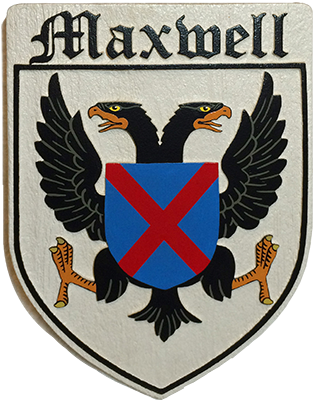
Although you can of course, technically have a coat of arms, there are some legalities involved, depending on whether you're looking for a legitimate coat of arms or a family crest, wall mounted or as a plaque. If you are looking for a family crest, now that is an entirely different animal, and it’s perfectly legal to use a crest (which is a specific part of a coat of arms) any way you choose. Whether you are looking for a family crest or a coat of arms, Lamb Sign Company will be pleased to produce the most impressive product you could expect from wood and paint. We do the research and submit proofs; upon approval we sandblast the background and give the utmost attention to detail and every brush stroke, and lovingly rendering the most accurate representation of your herald as possible.
So let’s get right down to it. If you are thinking about displaying your own coat of arms, there are a couple of facts you should be aware of. First, legally, you have to be a male. Secondly, you have to have a direct bloodline descent to the original knight who earned the crest. Third, even if you are of direct descent, all parents of said lineage must have been bound by matrimony; no illegitimate offspring are permitted to use or display the original coat of arms, henceforth referred to as “arms”. Having a coat of arms or family crest is a very rare thing. However, having the hereditary right to use it is an even greater rarity.
When discussing the illegitimate use of the arms, you might wonder what the punishment is for illegal use of the arms. Will the European Coat of Arms Protection Unit come and handcuff you and throw you in a dingy old European dungeon? It depends on where you live, actually.
In general courts overlook the misuse, in spite of the fact that there are some very rare examples of patents being issued for arms of descent. I proudly, however illegally (being a woman), display my own Maxwell arms, which is made even more illegal due to the lack of modification for my current Maxwell clan. More on this later.
If you live in Scotland, or are of Scottish descent, then the answer yes, you can be prosecuted for misuse of arms. In Scotland, it is illegal to use the arms of someone else, and if you make up your own arms, then you are using bogus arms. In both cases you are committing an offence and may be charged and tried at Lyon Court, which is an active court of law. This makes Scottish heraldry one of the most tightly controlled in the world, and it is one of the few countries where heraldry is protected by law, and is still actively enforced. Until you prove your lineage and obtain a set at the Lyon Court in Edinburgh, you are considered to have no arms whatsoever. Even if you are the direct heir, it is considered proper to re-apply with the Court every few generations to keep your title up to date.
Throughout the centuries, the use of arms was governed primarily by custom with the exception of England. England has had strict regulations since their development and use throughout the middle ages. While most European countries no longer regulate their use, in the UK there are still laws there governing the use of arms that "must" be followed by anyone in any part of the world who wishes to use them.
In our modern society, the use of arms continues to be closely regulated, and many of them have been trademarked. Today, nearly anyone can claim arms, as long as they’re not trademarked. Overseeing the issuance of new coats of arms is The College of Arms, also known as the College of Heralds, based in London. The College of Arms is a royal corporation comprised of professional officers of arms. They have jurisdiction over England, Wales, Northern Ireland and some of the Commonwealth realms. They are the authority regarding the use and issuance of arms, new or ancient.
These officers are appointed by the British Sovereign and are delegated authority to act on behalf of the Crown in all matters of heraldry, including the use of all flags on land. The College was founded in 1484 by King Richard III, and its duties include record keeping of all official registers of flags, as well as the meanings and significance of national symbols. The College is fully self-supporting and receives no public monies, in spite of the fact that it is part of the Royal Household of the United Kingdom.
The College of Arms can grant the use of new arms even today. The thing to remember is that a coat of arms is good for an individual only. There is no such thing as arms for a surname. Many people with the same surname will have completely different arms, and many people with the same surname are not entitled to arms at all (in the case of illegitimacy). For any individual to have a right to arms, they must have been personally granted use, or be descended in a legitimate male line. With one exception:
Women are allowed to inherit arms only when there is no male heir. Her father’s arms will continue only if she marries a man with arms; their combined shield will include the arms that were her father’s.
In England, the right to bear a coat of arms passes to all male descendants of the grantee. Meanwhile in Scotland, a coat of arms is considered to be inheritable property and thus can only belong to one person at a time. This means that the younger sons of a grantee have no direct right to inherit the arms until elder branches of the family have died out. All younger sons must apply for new arms with a minor distinction in order to possess legally.
On the Origin of the Coat of Arms
It is believed that the original intent of arms on a shield was simply to help the knights to identify each other on the battlefield. Later, when the knight or feudal lord who distinguished himself on the battlefield, earned a herald, he was the only one entitled to use it. In England and Scotland, it was specifically decreed that it was for the individual’s use only, being granted by the ruling monarch, and that it could not be passed down to his offspring for use. It could be displayed as a flag over his castle or manor while he lived, but it was to expire with him. Such a waste!
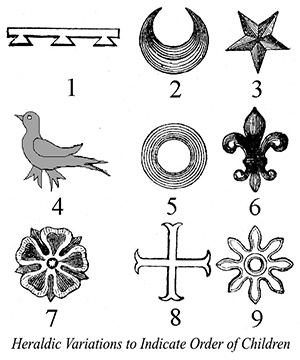
In most of Europe, only the aristocracy was permitted the use of arms, while in Germanic countries, both common folk and non-noble aristocrats could be granted a coat of arms for distinguished accomplishments.
Things changed in the 13th century during the first Crusades, when King Richard I made coats of arms hereditary with one caveat: each generation had to make a small change in the blazon so that it would be unique to the family. He also decreed that women may be allowed to bear their own arms, as long as elements identifying them as women be added to the main family design. Coats of arms usually started out fairly simple in design, and subsequent generations added onto or made slight variations to the design to make it uniquely their own. Marriages often resulted in a combination of two different family lines’ coats of arms.
With each generation, in fact with each child, a coat of arms gets progressively more complicated. In a system said to have been invented around 1500, small symbols were added to the shield to indicate the order of children: the eldest son (during the lifetime of his father) had a horizontal strip with three pendent drops. The second son had a crescent, the third a mullet (star), the fourth a martlet (bird), the fifth an annulet (like the letter “O”), the sixth a fleur de lis, the seventh a rose, the eighth a cross Moline (like St. John’s cross), and the ninth a double quatrefoil. Imagine the record-keeping!
What Comprises a Coat of Arms?
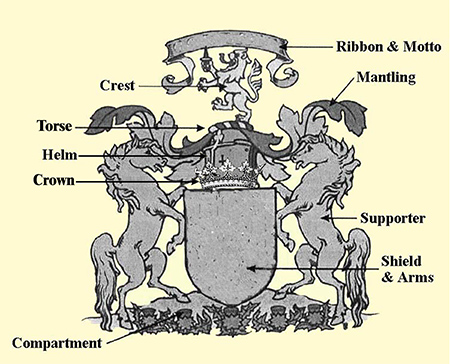
A coat of arms has many parts. The Shield is central. It carries the colors, animals, and/or symbols as described
The definition of "blazon"
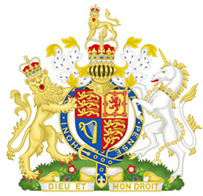
The term “blazon” means to describe, either verbally or in writing, the elements of a coat of arms using formal heraldic language. Such as, “Supporters, sinister a unicorn Argent armed, crined and unguled Proper, gorged with a coronet Or composed of crosses patée and fleurs de lys a chain affixed thereto passing between the forelegs and reflexed over the back also Or”. This describes the unicorn in this particular coat of arms. From www.commons.wikimedia.org
in the blazon. The shape of the shield is not described in the blazon and it can vary depending on geographical area and period of time. Sometimes the shape of the shield can be an indication of where the family came from.
Under the shield is the Compartment which is used to support the shield. It is usually comprised of rocks, a grassy mound, or some sort of other landscape upon which the supporters are standing, and which the shield rests upon. It is said to represent the land belonging to the bearer.
A Supporter is usually a human being or a pair of animals placed on either side of a shield as if they were holding or "supporting" the shield.
The Crown or Coronet sits immediately on top of the shield (when it appears), and is a symbol of power and protection received from someone or a sovereign state, or means that the owner of the crown guarantees you power and protection. Crowns can also appear on the shield to signify the status of the bearer.
The Helm, or helmet, is not a part of an official blazon, and may or may not appear on a coat of arms. When present, it appears above the shield, and can vary depending on the bearer’s rank, time period, or simply the artist’s preference.
The inclusion of the Mantle is a very interesting facet of the coat of arms: Most warriors wore a combination of metal armor; chain male (a metal mesh used like fabric); and leather, studded with metal embellishments. Their primary mode of transportation was either on foot or horse. As these warriors traveled from one destination to another, their armor could be extremely uncomfortable in the hot sun or the pouring rain. For this reason they wore capes or cloaks which reflected the sun off the metal gear and also protected it from the rain. Some say that in battle, their capes or mantles also helped deflect sword thrusts. Coming home with torn and shredded mantling would have indicated a fierce battle and a very brave warrior. So in heraldry, the mantling is shown torn, tattered, and flowing, as if the warrior was charging the battlefield on horseback.
The Torse or Wreath is a twisted roll of fabric which sits on top of the helm and just under the crest. It has the dual purpose of masking the joint between helm and crest, and supposedly holds the mantle in place. Some say that the torse was borrowed from the Middle Eastern cultures.
The Crest is whatever appears above the helm and torse (or above the shield, if neither a helm nor torse is present). The crest is part of the official blazon, and is the source of much confusion when used legally as the family crest. The crest has been used throughout time as a family badge. Gaelic tradition has allowed the crest part of the coat of arms to be used in a circular setting (usually within a belt, complete with buckle), thus giving all members of the family the right to use it. The crest part of a coat of arms has been used for centuries on engravings, rings, bookplates, and all manner of items to display a family’s heritage. However, over the course of time, the phrase “family crest” has become synonymous with “coat of arms”.
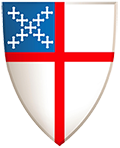
Eventually, the use of a crest came to be adopted by churches, towns and even businesses. Here is the shield of The Episcopalian Church in the United States, developed after the American Revolution when it separated itself from the Church of England; their clergy are required to swear allegiance to the British monarch as Supreme Governor of the Church of England. The Episcopal shield displays nine Saint Andrew’s crosses in the shape of a Saint Andrew’s cross in order to represent the nine original Dioceses which signed the 1789 PECUSA (Protestant Episcopal Church in the United States of America) Constitution.
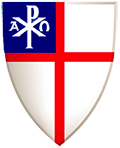
Closely related is the shield of the Anglican Province of America (APA). The only difference is the symbolism in the upper left corner. The APA shield replaces the Saint Andrew’s crosses with Holy Scripture: the Alpha and Omega refers to the Divine Person of God, the Son Jesus Christ, who was God made Man (Revelation 1.8). The Chi-Rho (XP) means “Christ” in Greek. The remarkable similarity between the two shields is due to the fact that the APA asserts herself to be a legitimate heir and successor of the Episcopal Church.
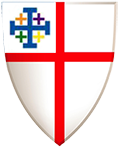
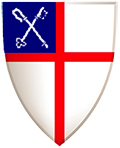
To further illustrate the idea of shield modification, here are the shields for The Universal Anglican Interspiritual Church and St. Thomas of Canterbury Anglican Catholic Church of Roanoke, VA; examples broad (religion) to specific (church).
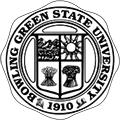
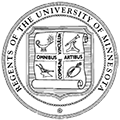
Universities that are worth their salt have a “logo” which often times incorporates the shield part of a heraldic coat of arms. Here (right) are two excellent examples: the author’s alma mater, Bowling Green State University; and the University of Minnesota.
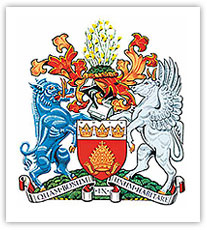
Even a town can be given a coat of arms. In 1901 the title of “royal borough” was granted to the dual townships of Kingsington and Chelsea in London to fulfill the wish of Queen Victoria, to give distinction to her birth place. Here is that Royal Charter. The Shield displays three Crowns on ermine symbolizing the Royal status of the borough, and an Abbot’s Mitre 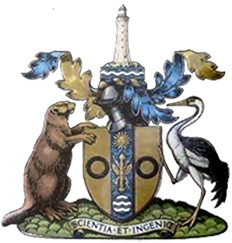 (traditional head-dress) signifying the centuries old connections that both townships had with their respective local abbeys. The supporting boar on the left is taken from the arms of the De Vere family who were Lords of the Manor of Kensington for 500 years. The supporting winged bull is associated with Saint Luke, the Patron Saint of the ancient Parish of Chelsea. The motto, “Quam Bonum In Unum Habitare” means “What a good thing it is to dwell together in unity”.
(traditional head-dress) signifying the centuries old connections that both townships had with their respective local abbeys. The supporting boar on the left is taken from the arms of the De Vere family who were Lords of the Manor of Kensington for 500 years. The supporting winged bull is associated with Saint Luke, the Patron Saint of the ancient Parish of Chelsea. The motto, “Quam Bonum In Unum Habitare” means “What a good thing it is to dwell together in unity”.
Some companies with royal charters were also given coats of arms, which are the precursor to the modern day logo. One example includes the Institution of Civil Engineers (shown right).
So, You Still Want a Coat of Arms?
Another option for legitimacy would be to contact the College of Arms for the country you believe your ancestor is from, and for a fee they will search their records to see if a coat of arms was awarded to your ancestor.
So ... we excuse ourselves for the misuse, and promise not to misrepresent.
Heraldry is a real art. There are organizations in the United Kingdom and other European countries that can help you interpret the meaning on a legitimate coat of arms if you discover one in your family. Even if you don’t have the right to use it, it is still interesting to know the meaning behind the arms your ancestors used. If you decide to buy a coat of arms from an online company (or offline company), just know it will likely be a new coat of arms and not something ancient and legitimate.
It doesn’t mean you can’t start using it as part of a new family tradition, though. By all means, start your own coat of arms now and pass it down through your family. Just be sure you record where and how the arms were started, and what the symbols you chose to put in it mean, so future generations will know how your family got its coat of arms.
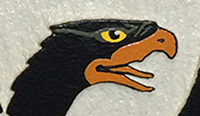
Here at Lamb Sign Company, we will be thrilled to help you with the research, or do the research for you (to find a commonly used family crest for your surname), deliver a proof, and produce a beautiful wood plaque with a sandblasted background and lovingly painted details of your arms or shield. A plaque similar to the "Maxwell" sample at the top of this page (measures 8.5" wide x 12" high) will cost $285 which includes having Lamb Sign Company produce similar artwork. We will be happy to produce a larger, simpler, more complicated (etc) coat of arms or family crest plaque for you or your loved one, and adjust the price accordingly.
© 2023, Lamb Sign Company • Fairview, NC 28730
828-628-6234